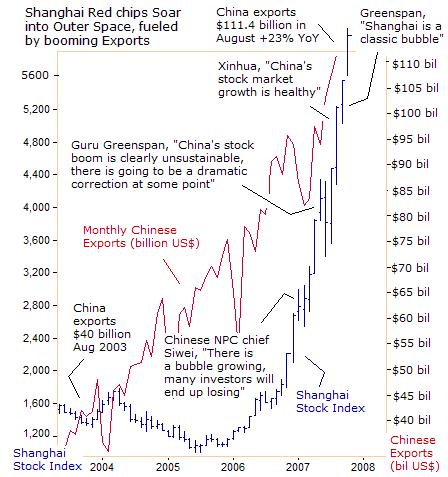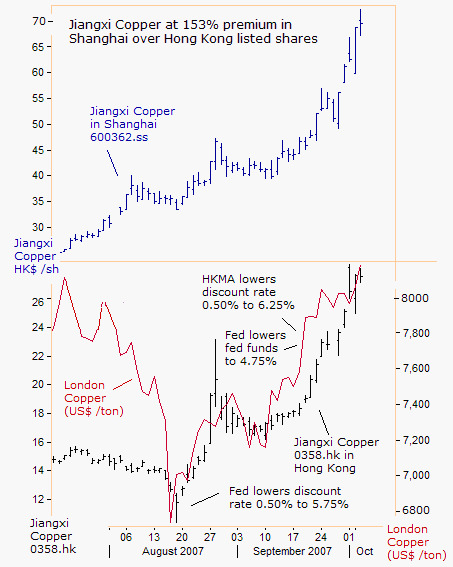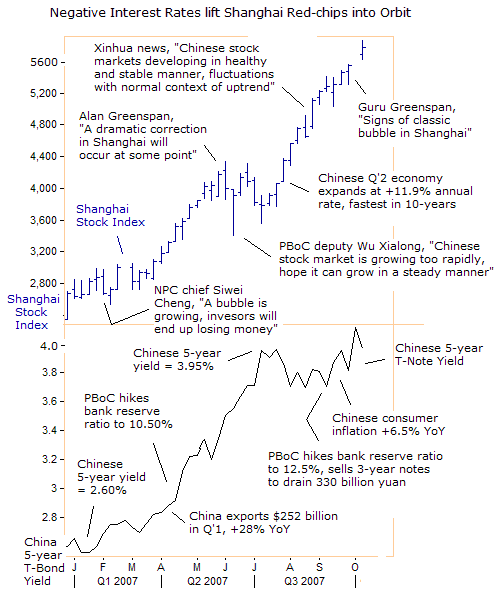|
|||
How high can Shanghai Red-chips fly?Gary Dorsch "There is a bubble growing.
Investors should be concerned about the risks," warned Cheng
Siwei, the vice-chairman of the National People's Congress in
an interview with the Financial Times on January 31st. "But
in a bull market, people will invest relatively irrationally.
Every investor thinks they can win. But many will end up losing.
But that is their risk and their choice," warned Cheng.
Last night, the Shanghai red-chip market hit a new all-time high of 5,913, up 118% so far this year, and up 55% from just three months ago. Shanghai red-chips have doubled since Cheng tried to put a lid on the market. Shanghai is arguably one of the greatest bull markets in history, and by most accounts, appears to be driven by China's booming exports and trade surpluses, which are hauling in large amounts of money from overseas into the world's fourth largest economy.  China posted a trade surplus of $25 billion in August, up from $18.8 billion a year earlier, fueled by exports, which grew 22.7%, with imports up 20.1%. The trade surplus hit a record high of $26.9 billion in June. For the first eight months of 2007, the surplus came to $161.7 billion. Foreign direct investment (FDI) was $41.9 billion. The rolling 12-month surplus rose to a whopping $245 billion. The Peoples' Bank of China (PBoC) prints massive amounts of yuan each day, in exchange for the foreign currency flowing into the country. As a result, China's M2 supply is 18% higher from a year ago. China's bulging trade surplus has swelled the country's foreign exchange reserves to $1.4 trillion, although a "small sum of hot money also sneaks into the financial system through various means," the official Shanghai Securities News reported on Sept 30th. Beijing's "strict capital controls have played a key role in stemming an otherwise unimaginable amount of capital inflow to the country," said Wang Guogang, vice-director of China's Financial Institute. "It is very improper to calculate the amount of hot money flowing into China by simply subtracting Chinese foreign exchange reserves from the sum of the trade surplus and FDI in the country," he said.  If such formula were to be used, there would be over $120 billion of hot money that has entered China so far this year, equivalent to 45% of the rise in the central bank's foreign exchange reserves in the first half of 2007. Hot money flows might be inflating Shanghai red-chips to huge premiums over their dually listed shares in Hong Kong. For instance, Jiangxi Copper, China's top integrated copper producer, is dually listed in Hong Kong, under symbol 0358.hk and in Shanghai under 600362.ss. Yet Jiangxi Copper trades at a 153% premium in Shanghai over the company's listed shares in Hong Kong. When Jiangxi Copper shares are converted from yuan terms into HK$ terms, it's trading at HK$69.50 in Shanghai, far above the HK$27.50 /share price in Hong Kong. Strict capital control between the two Chinese currencies prevents arbitrage and exchanging of shares between the two stock markets. The market craze in Shanghai, catapulted Shenhua Energy 601088.SS, 1088.HK, sharply higher last week, surging 87% in its Shanghai IPO listing, and climbing a further 10% to 76.23 yuan /share the next day. The price-earnings ratio for all Shanghai-listed stocks is roughly 43, which is very high by international standards.  To curb excess liquidity, China raised bank reserve requirement ratios by 3.5% to 12.5% so far this year, and plans to issue 800 billion yuan of special treasury bonds to soak up (sterilize) some of the yuan that it has printed this year. China raised the one-year deposit by 0.81% to 3.87% this year, and reduced the withholding tax on interest income to 5% from 20% as of August 15. But the yield on China's 5-year T-note stopped climbing since early July, and is stuck at 3.95% today, or roughly 2.5% below China's consumer price inflation (CPI) rate, yielding a huge negative rate of return, when adjusted for inflation. Since the PBoC prints more yuan than it soaks up, the money supply is still growing rapidly at 18%, and when Chinese investors are offered negative interest rates of 2.5%, the only alternative is to buy red-chips and gold. Once the yield on China's 5-year T-note peaked at 3.95% in July, the Shanghai red-chip market became unleashed and soared 54% over the next three months. The powerful rise of Shanghai Red-chips was in defiance of predictions by former Federal Reserve chief "Easy" Al Greenspan, who said on May 23rd, that the boom in Chinese stocks could not last, soon after Shanghai red-chip index approached 4,000. "It is clearly unsustainable. There's going to be a dramatic contraction at some point," Greenspan declared. But three months later, Shanghai rallied to 5,913. "If you ever want to get a definition of a bubble in the works, that's it," Greenspan told reporters in London on October 1st, referring to the Shanghai market at 5,200. And who knows more about blowing bubbles into asset markets, than "Easy" Al, a serial bubble blower at the Fed. But Shanghai traders aren't willing to call an end to the uptrend just yet, although profit-taking is expected near the 6,000 level. To read the rest of this article, please click on the link below, http://sirchartsalot.com/article.php?id=70 Oct 11, 2007 |
